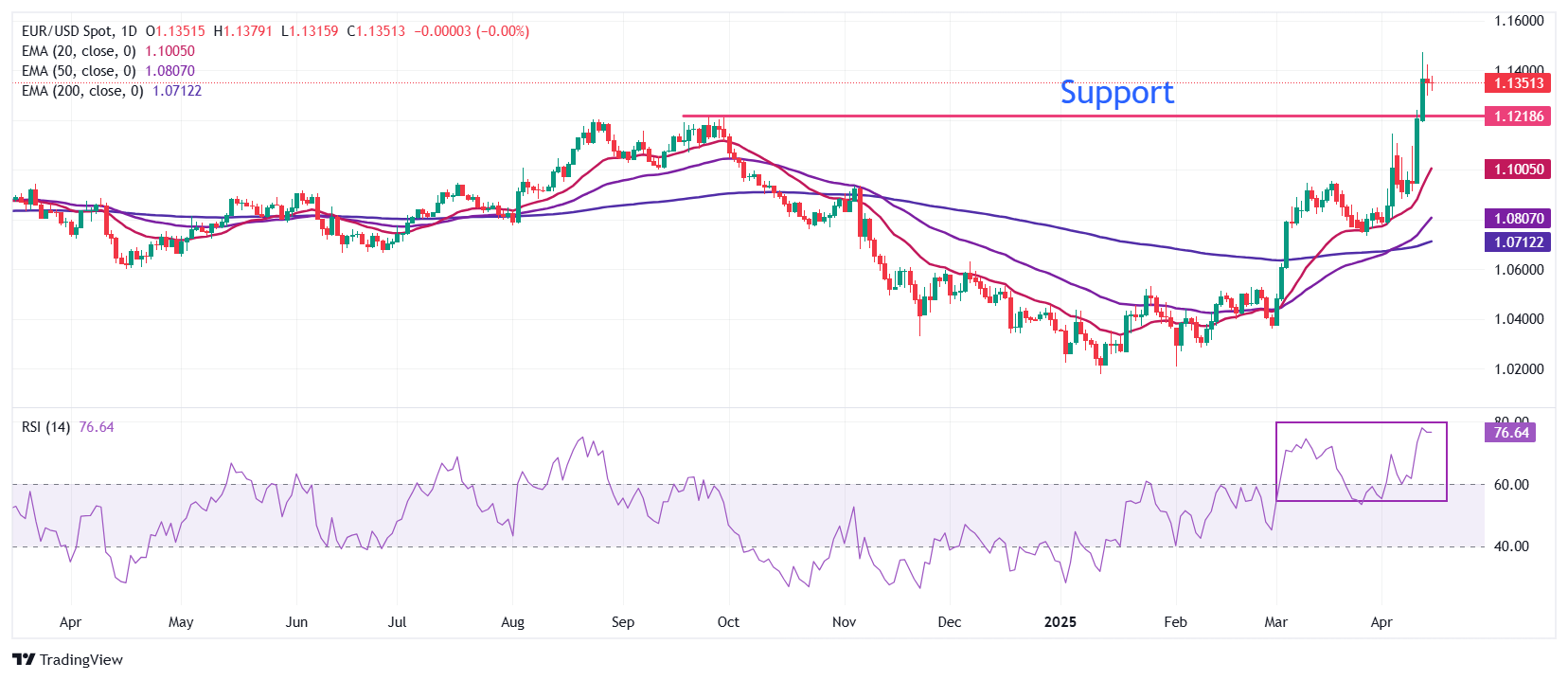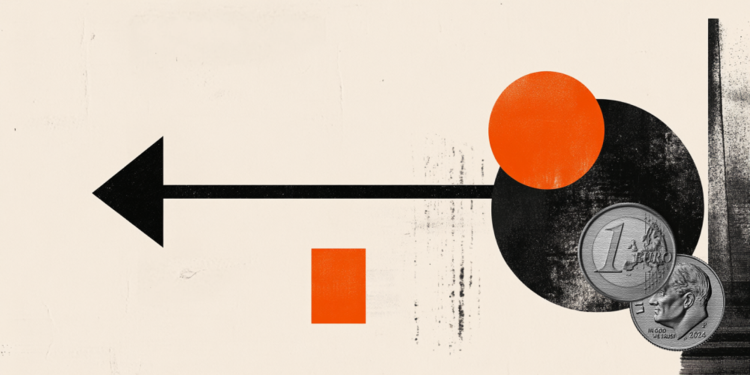- EUR/USD trades back and forth around 1.1350 as investors gauge clarity on Trump’s tariff policy.
- Fed Waller backs interest rate cuts due to escalating US recession risks.
- The ECB is widely anticipated to cut interest rates by 25 bps on Thursday.
EUR/USD demonstrates a sideways trend near 1.1350 during European trading hours on Tuesday after a sharp run-up in the last few trading days. The major currency pair consolidates as the US Dollar (USD) gains a temporary cushion after remaining under pressure for over a week. The US Dollar Index (DXY), which tracks the Greenback’s value against six major currencies, finds ground near a fresh three-year low near 99.00, posted on Friday.
However, investors brace for more weakness in the US Dollar as the currency is losing its safe-haven status due to ever-shifting tariff headlines by United States (US) President Donald Trump since last week.
After declaring a 90-day pause in the execution of reciprocal tariffs on all of its trading partners, except China, US President Trump is planning to announce a temporary suspension of automobile levies. This would buy time for domestic automakers to set up manufacturing facilities at home.
Additionally, heightened fears of an economic slowdown due to Trump’s economic policies have also weighed on the US Dollar and have strengthened US Treasury yields. Historically, yields on interest-bearing assets increase sharply as financial market participants add the risk premium in times of economic uncertainty. 10-year US Treasury yields have increased over 13% in the last six trading sessions.
Rising bond yields and escalated fears of an economic slowdown are expected to jeopardize the Federal Reserve’s (Fed) monetary policy outlook. On Monday, Fed Governor Christopher Waller warned that the “new tariff policy” is one of the “biggest shocks” to affect the US economy in decades. Waller gave more weightage to brewing fears of an economic recession over accelerating inflation expectations and backed monetary policy easing. He anticipated that the “effects of tariffs in raising inflation” will be “short lived”.
Daily digest market movers: EUR/USD consolidates as investors await ECB monetary policy
- The sideways move in the EUR/USD pair is also driven by a cautious trend in the Euro (EUR) ahead of the European Central Bank’s (ECB) monetary policy decision, which will be announced on Thursday. The ECB is almost certain to cut its Deposit Facility Rate by 25 basis points (bps) to 2.25%. This would be the sixth straight interest rate cut by the ECB in a row.
- Investors will pay close attention to ECB President Christine Lagarde’s press conference to get cues about the likely monetary policy outlook for the remaining year and how new trade policies by US President Trump will shape the Eurozone economy.
- A slew of ECB officials has commented that Trump’s tariffs-led-inflation won’t be persistent and will lead to significant economic risks. An increase in Trump-driven inflation would be offset by China dumping their products into the Euro area. The escalating trade war between the US and China would force the latter to look for other economies to sell their goods. The tariff war between the US and China escalated after the Asian giant retaliated against Trump’s reciprocal tariffs by increasing duties on imports from America.
- On the global front, trade relations between the US and the Eurozone are expected to become healthy. US National Economic Council (NEC) Kevin Hassett said in an interview with Fox Business Network on Monday that they are making “enormous progress” on tariff talks with the European Union (EU).
Technical Analysis: EUR/USD trades sideways around 1.1350

EUR/USD wobbles around 1.1350 in Tuesday’s European session. The overall outlook of the major currency pair is strongly bullish as all short-to-long Exponential Moving Averages (EMAs) slope higher.
The 14-day Relative Strength Index (RSI) jumps above 70.00, indicating a strong bullish momentum.
Looking up, the psychological resistance of 1.1500 will be a major resistance for the pair. Conversely, the April 11 low of 1.1192 will be the key support for the Euro bulls.
Euro FAQs
The Euro is the currency for the 19 European Union countries that belong to the Eurozone. It is the second most heavily traded currency in the world behind the US Dollar. In 2022, it accounted for 31% of all foreign exchange transactions, with an average daily turnover of over $2.2 trillion a day.
EUR/USD is the most heavily traded currency pair in the world, accounting for an estimated 30% off all transactions, followed by EUR/JPY (4%), EUR/GBP (3%) and EUR/AUD (2%).
The European Central Bank (ECB) in Frankfurt, Germany, is the reserve bank for the Eurozone. The ECB sets interest rates and manages monetary policy.
The ECB’s primary mandate is to maintain price stability, which means either controlling inflation or stimulating growth. Its primary tool is the raising or lowering of interest rates. Relatively high interest rates – or the expectation of higher rates – will usually benefit the Euro and vice versa.
The ECB Governing Council makes monetary policy decisions at meetings held eight times a year. Decisions are made by heads of the Eurozone national banks and six permanent members, including the President of the ECB, Christine Lagarde.
Eurozone inflation data, measured by the Harmonized Index of Consumer Prices (HICP), is an important econometric for the Euro. If inflation rises more than expected, especially if above the ECB’s 2% target, it obliges the ECB to raise interest rates to bring it back under control.
Relatively high interest rates compared to its counterparts will usually benefit the Euro, as it makes the region more attractive as a place for global investors to park their money.
Data releases gauge the health of the economy and can impact on the Euro. Indicators such as GDP, Manufacturing and Services PMIs, employment, and consumer sentiment surveys can all influence the direction of the single currency.
A strong economy is good for the Euro. Not only does it attract more foreign investment but it may encourage the ECB to put up interest rates, which will directly strengthen the Euro. Otherwise, if economic data is weak, the Euro is likely to fall.
Economic data for the four largest economies in the euro area (Germany, France, Italy and Spain) are especially significant, as they account for 75% of the Eurozone’s economy.
Another significant data release for the Euro is the Trade Balance. This indicator measures the difference between what a country earns from its exports and what it spends on imports over a given period.
If a country produces highly sought after exports then its currency will gain in value purely from the extra demand created from foreign buyers seeking to purchase these goods. Therefore, a positive net Trade Balance strengthens a currency and vice versa for a negative balance.

